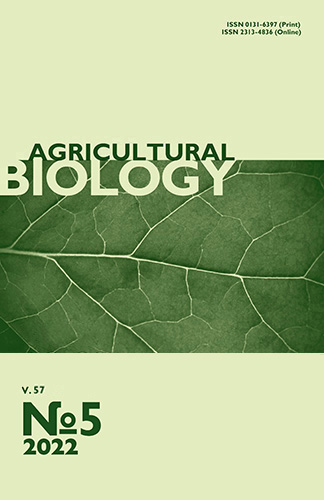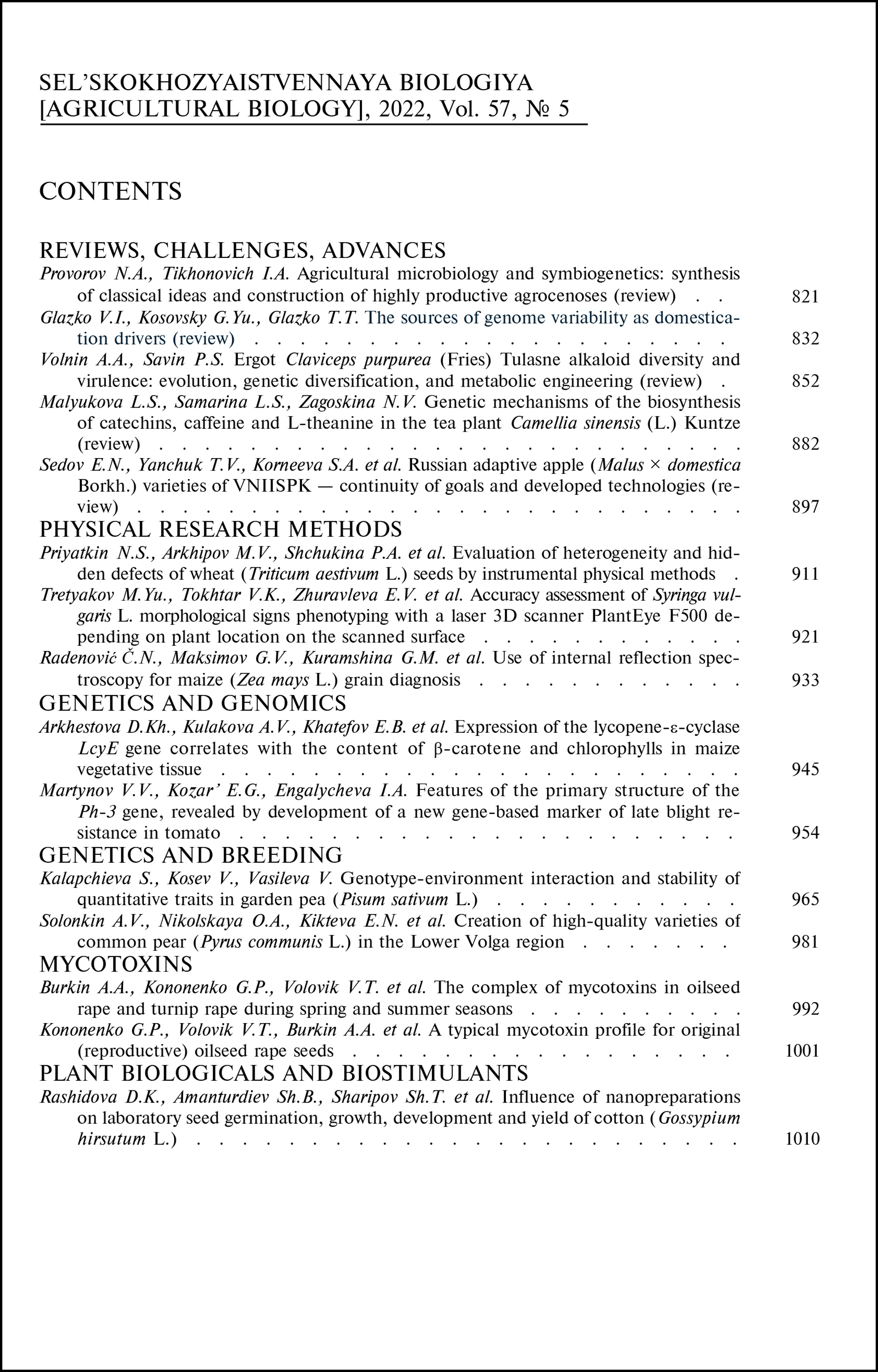doi: 10.15389/agrobiology.2022.5.1010eng
UDC: 633.511:581.1:631.811.98
INFLUENCE OF NANOPREPARATIONS ON LABORATORY SEED GERMINATION, GROWTH, DEVELOPMENT AND YIELD OF COTTON (Gossypium hirsutum L.)
D.K. Rashidova1 ✉, Sh.B. Amanturdiev1, Sh.T. Sharipov1, N.M. Mamedov1, M.M. Yakubov2
1Cotton Breeding, Seed Production and Agrotechnologies Research Institute, 1 University street, Salar town, Kibray district, Tashkent region, Republic of Uzbekistan 111218, e-mail etoile111@yandex.ru (✉ corresponding author), amanturdievshavkat@mail.ru, sh.sharipov1972@mail.ru, mukhammadmnm@mail.ru;
2Tashkent State Agrarian University, Tashkent region, Kibray district, Universitet street 2-house, Republic of Uzbekistan 100140, e-mail yakubov.m.m@mail.ru
ORCID:
Rashidova D.K. orcid.org/0000-0001-5174-9730
Mamedov N.M. orcid.org/0000-0001-7140-6356
Amanturdiev Sh.B. orcid.org/0000-0002-7347-267X
Yakubov M.M. orcid.org/0000-0002-6948-028X
Sharipov Sh.T. orcid.org/0000-0001-5109-2345
Received April 26, 2022
Currently, an important role is given to technologies based on a wide range of environmentally friendly plant protection products. The nanopolymer bioactive preparations based on chitosan from the silkworm (Bombyx mori Linnaeus, 1758) pupae with fungicidal and bactericidal properties are well suited for pre-sowing treatment of crop seeds. Here, for the first time, it was revealed that the seed treatment with nanopolymer preparations containing copper and silver ions accelerates the growth and development of seedlings and increases the yield of cotton cultivar Andijan 36. Our aim was to evaluate the effect of biologically active nanopolymer complexes based on chitosan and its derivatives on the morphophysiological and sowing parameters of seeds, the economically valuable qualities of raw cotton, and the yield of cotton in lab tests and under field conditions (the Research Institute of Selection, Seed Production and Agro-Technology of Cotton Growing, 2018-2020). In the experiments, we used nanopolymeric preparations PMC (polymer-metal complex) Cu2+:Ag 7:3, PMC Cu2+:Ag 8:2, Na-nochitosan (NanoChS, 0.5 %, 90 kDa), Nanoascorbachitazan (NanoAChS, 0.5 %, chitosan:ascorbic acid 4:1) and polymer preparations Chitosan initial 0.5 %, Kuprimhit 0.5 %, Ascorbatchitosan (AChS). Preparations UZKHITAN (Institute of Chemistry and Physics of Polymers of the Academy of Sciences of the Republic of Uzbekistan) and Dalbron (Dalston associated SA, Panama) served as standards, seeds without processing served as control. Seeds (n = 36) of cotton (Gossypium hirsutum L.) cultivar Andijan 36 were soaked in preparations (at the rate of 20 l/t seeds) at least 3-4 days before sowing. In each variant of the experiment, 6 kg of cotton seeds were treated. In lab tests, the seeds were germinated in sand at 25 °С and a 60-65 % air humidity. Germination energy was determined on day 4, germination on day 12. The length of the aboveground and underground parts of the seedlings was measured on days 3, 5, 7, 9, and 10. Field experiments were carried out at the experimental farm of NIISSAVKh (Tashkent region, Kibray district, Salar settlement). The emergence of seedlings was registered, field germination was assessed, and phenological observations were made over the plant growth and development period from June 1 to September 1. To assess the economically valuable characteristics of raw cotton (fiber yield, weight per box, fiber length), test samples were collected before harvesting. Yields were recorded on September 15, October 1, October 15, and November 1. In lab tests, the seeds treated with PMC Cu2+:Ag 8:2, NanoAChS 0.5 %, 4:1 or PMC Cu2+:Ag 7:3 had the best germination rate, the 96.0, 96.0, and 97.0 %, respectivey, that exceeded the control by 4.0-5.0 % and the Dalbron standard by 2.0-3.0 %. The aboveground part of the seedlings with NanoAChS treatment turned out to be 0.6-4.6 mm longer than that with AChS, the underground part was 0.1-2.1 mm longer. The differences between NanoChS and Chitosan were 0.3-2.1 mm and 0.8-2.3 mm, respectively, between PMC Cu2+:Ag 8:2 and Kuprumhit — 0.3-4.1 mm and 0.1-2.7 mm. On days 3, 5, 7, 9, and 10, plants from seeds treated with nanopolymer preparations outperformed those threated with polymer preparations. PMC Cu2+:Ag 8:2, NanoAChS and NanoChS had a more pronounced effect on seed germination and length of the aboveground and underground parts of the seedlings than their polymer counterparts. In field tests, the best indicators of growth and development were recorded for PMC Cu2+:Ag 8:2, PMC Cu2+:Ag 7:3, and NanoAChS 0.5 %, specifically, the plant height on September 1 exceeded the control by 7.4; 8.0; 7.7 cm, the number of sympodial branches by 1.5; 1.2; 0.6 pcs, the number of boxes by 2.4; 1.8; 2.5 pcs. Also, upon seed treatments with PMC Cu2+:Ag 8:2 and PMC Cu2+:Ag 7:3, the cotton yields exceeded the control by 4.0 and 3.7 c/ha, respectively, and the Dalbron standard by 3.3 and 3.0 c/ha. A trend towards higher yields was observed from the first crop count. Therefore, nanopolymeric preparations PMC Сu2+:Ag 7:3 and PMC Сu2+:Ag 8:2 can be used for cotton seed encapsulation.
Keywords: Gossypium hirsutum L., cotton, seeds, variety, nanopreparations, germination, seedling length, phenological observation, growth, development, raw cotton, yield.
REFERENCES
- Rai M., Ingle A. Role of nanotechnology in agriculture with special reference to management of insect pests. Appl. Microbiol. Biotechnol., 2012, 94(2): 287-293 CrossRef
- Ghormade V., Deshpande M.V., Paknikar K.M. Perspectives for nano-biotechnology enabled protection and nutrition of plants. Biotechnology Advances, 2011, 29(6): 792-803 CrossRef
- Amanturdiev Sh.B. Deystvie nanopreparatov na osnove khitozana i ego proizvodnykh na morfofiziologicheskie pokazateli i posevnye kachestva semyan sel’skokhozyaystvennykh kul’tur (khlopchatnik, pshenitsa, soya). Doktorskaya dissertatsiya [The effect of nanopreparations based on chitosan and its derivatives on morphophysiological parameters and sowing qualities of seeds of agricultural crops (cotton, wheat, soybeans). DSc Thesis]. Tashkent, 2021 (in Russ.).
- Lee S., Kim S., Kim S., Lee I. Effects of soil-plant interactive system on response to exposure to ZnO nanoparticles. J. Microbiol Biotechnol., 2012, 22(9): 1264-1270 CrossRef
- Ge Y., Priester J.H., Van De Werfhorst L.C., Schimel J.P., Holden P.A. Potential mechanisms and environmental controls of TiO2 nanoparticle effects on soil bacterial communities. Environ. Sci. Technol., 2013, 47(24): 14411-14417 CrossRef
- Ghormade V., Deshpande M.V., Paknikar K.M. Perspectives for nano-biotechnology enabled protection and nutrition of plants. Biotechnology Advances, 2011, 29(6): 792-803 CrossRef
- Johansen A., Pedersen A.L., Jensen K.A., Karlson U., Hansen B.M., Scott-Fordsmand J.J., Winding A. Effects of C60 fullerene nanoparticles on soil bacteria and protozoans. Environmental Toxicology and Chemistry, 2008, 27(9): 1895-1903 CrossRef
- Nowack B., Ranville J.F., Diamond S., Gallego-Urrea J.A., Metcalfe C., Rose J., Horne N., Koelmans A.A., Klaine S.J. Potential scenarios for nanomaterial release and subsequent alteration in the environment. Environmental Toxicology and Chemistry, 2012, 31(1): 50-59 CrossRef
- Priester J.H., Ge Y., Chang V., Stoimenov P.K., Schimel J.P., Stucky G.D., Holden P.A. Assessing interactions of hydrophilic nanoscale TiO2 with soil water. Nanopart. Res., 2013, 15(9): 1899-1893 CrossRef
- Tong Z., Bischoff M., Nies L., Applegate B., Turco R.F. Impact of fullerene (C60) on a soil microbial community. Environ. Sci. Technol., 2007, 41(8): 2985-2991 CrossRef
- Akinshina N., Rashidova D.K., Azizov A.A. Seed encapsulation in chitosan and its derivatives restores levels of chlorophyll and photosynthesis in wilt-affected cotton (Gossypium L., 1753) plants. Sel'skokhozyaistvennaya Biologiya, [Agricultural Biology], 2016, 51(5): 696-704 CrossRef
- Dananjaya S.H.S., Erandani W.K.C.U., Kim C.-H., Nikapitiya C., Lee J., De Zoysa M. Comparative study on antifungal activities of chitosan nanoparticles and chitosan silver nano composites against Fusarium oxysporum species complex. International Journal of Biological Macromolecules, 2017, 105(1): 478-488 CrossRef
- Ilk S., Sağlam N., Özgen M., Korkusuz F. Chitosan nanoparticles enhances the anti-quorum sensing activity of kaempferol. International Journal of Biological Macromolecules, 2017, 94(A): 653-662 CrossRef
- Liang R., Li X., Yuan W., Jin S., Hou S., Wang M., Wang H. Anti-fungal activity of nanochitin whisker against crown rot diseases of wheat. J. Agric. Food Chem., 2018, 66(38): 9907-9913 CrossRef
- Nakasato D.Y., Pereira A.E.S., Oliveira J.L., Oliveira H.C., Fraceto L.F. Evaluation of the effects of polymeric chitosan/tripolyphosphate and solid lipid nanoparticles on germination of Zea mays, Brassica rapa and Pisum sativum. Ecotoxicology and Environmental Safety, 2017, 142: 369-374 CrossRef
- Shajahan A., Shankar S., Sathiyaseelan A., Narayan K.S., Narayanan V., Kaviyarasan V., Ignacimuthu S. Comparative studies of chitosan and its nanoparticles for the adsorption efficiency of various dyes. International Journal of Biological Macromolecules, 2017, 104(B): 1449-1458 CrossRef
- Stauber R.H., Siemer S., Becker S., Ding G.B., Strieth S., Knauer S.K. Small meets smaller: effects of nanomaterials on microbial biology, pathology and ecology. ACS Nano,2018, 12(7): 6351-6359 CrossRef
- Divya K., Jisha M.S. Chitosan nanoparticles preparation and applications. Environ. Chem. Lett., 2018, 16: 101-112 CrossRef
- Nguyen V.S., Dinh M.H., Nguyen A.D. Study on chitosan nanoparticles on biophysical characteristics and growth of Robusta coffee in green house. Biocatalysis and Agricultural Biotechnology, 2013, 2(4): 289-294 (doi: 10.1016/j.bcab.2013.06.001">CrossRef
- Li R., He J., Xie H., Wang W., Bose S.K., Sun Y., Hu J., Yin H. Effects of chitosan nanoparticles on seed germination and seedling growth of wheat (Triticum aestivum L.). International Journal of Biological Macromolecules, 2019, 126: 91-100 CrossRef
- Rashidova S.Sh., Milusheva R.Yu. Khitin i khitozan Bombyx mori. Sintez, svoystva i primenenie [Chitin and chitosan of Bombyx mori. Synthesis, properties and applications]. Tashkent, 2009 (in Russ.).
- Metodika Dala tazhribalarini ўrganish uslublari. Toshkent, 2014 (in Uzbek">CrossRef
- O’zDSt 663:2017 Semena khlopchatnika posevnye. Tekhnicheskie usloviya [O’zDSt 663:2017 Cotton seeds for sowing. Specifications]. Tashkent, 2017 (in Russ.).
- O’zDSt 1080:2013 Khlopok syrets semennoy i semena khlopchatnika posevnye: metody otbora prob [O’zDSt 1080:2013 Cotton seed material and cotton seeds for sowing: sampling methods]. Tashkent, 2013 (in Russ.).
- O’zDSt 1128:2013 Semena khlopchatnika posevnye. Metody opredeleniya vskhozhesti [O’zDSt 1128:2013 Cotton seeds for sowing. Germination assessment methods]. Tashkent, 2013 (in Russ.).
- Dospekhov B.A. Metodika polevogo opyta [Methods of field trials]. Moscow, 1985 (in Russ.).
- Zel’dovich Ya.B., Myshkis A.D. Еlementy prikladnoy matematiki [Elements of applied mathematics]. Moscow, 1972 (in Russ.).
- Azura M.S.N., Zamri I., Rashid M.R., Shahrin G.M., Rafidah A.R., Rejab I.M., Azima A., Suria M.S., Amyita W.U. Evaluation of nanoparticles for promoting seed germination and growth rate in MR263 and MR269 paddy seeds. Journal of Tropical Agriculture and Food Science, 2017, 45(1): 13-24.
- Vokhidova N.R., Pirniyazov K.K., Yunusov M.Yu., Milusheva R.Yu., Rashidova S.Sh. Synthesis and some physical and chemical properties of metal complexes of the Bombyx mori chitosan. 13thSchool-Conference for 7 Young Scientists «Current Topicsin Organic Chemistry». Novosibirsk, 2010: 94.
- Polishchuk S.D., Nazarova A.A., Stepanova I.A., Kutskir M.V., Churilov D.G. Nanotekhnika, 2014, 1(37): 72-81 (in Russ.).
- Karimovna R., Balkibaevich A., Rashidova S. Efficiency of nanopolymer application on the growth, development and yield of soybean. Journal of Experimental Biology and Agricultural Sciences,2020, 8(6): 799-809 CrossRef
- Saharan V., Kumaraswamy R.V., Choudhary R.C., Kumari S., Pal A., Raliya R., Biswas P. Cu-chitosan nanoparticle mediated sustainable approach to enhance seedling growth in maize by mobilizing reserved food. J. Agric. Food Chem., 2016, 64(31): 6148-55 CrossRef
- Wang M., Chen Y., Zhang R., Wang W., Zhao X., Du Y., Yin H. Effects of chitosan oligosaccharides on the yield components and production quality of different wheat cultivars (Triticum aestivum L.) in Northwest China. Field Crops Research, 2015, 172: 11-20 CrossRef
- Zeng D.-F., Zhang L. A novel environmentally friendly soybean seed-coating agent. Acta Agriculturae Scandinavica, Section B — Soil & Plant Science, 2010 60(6): 545-551 CrossRef












